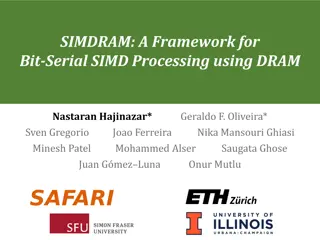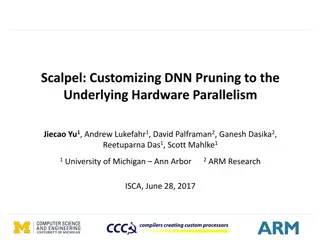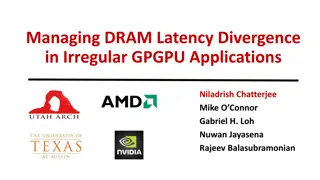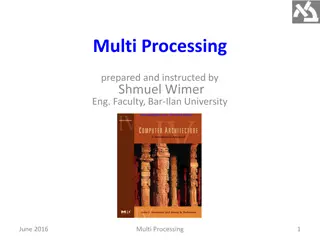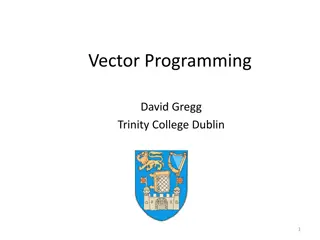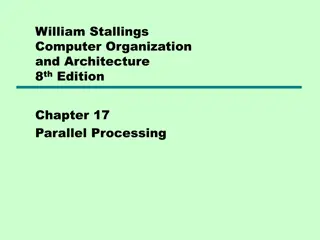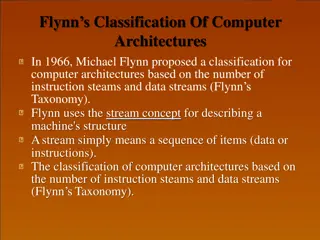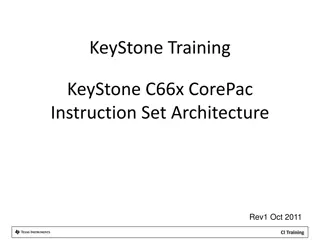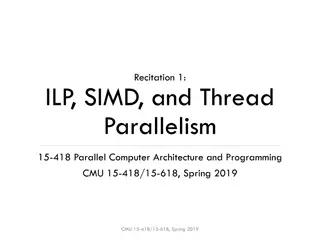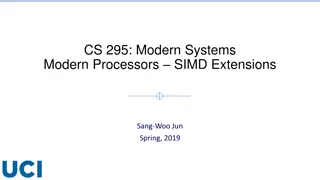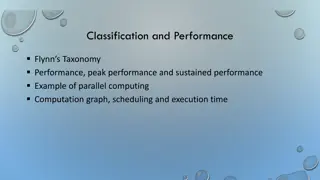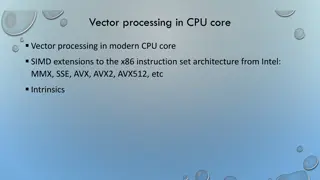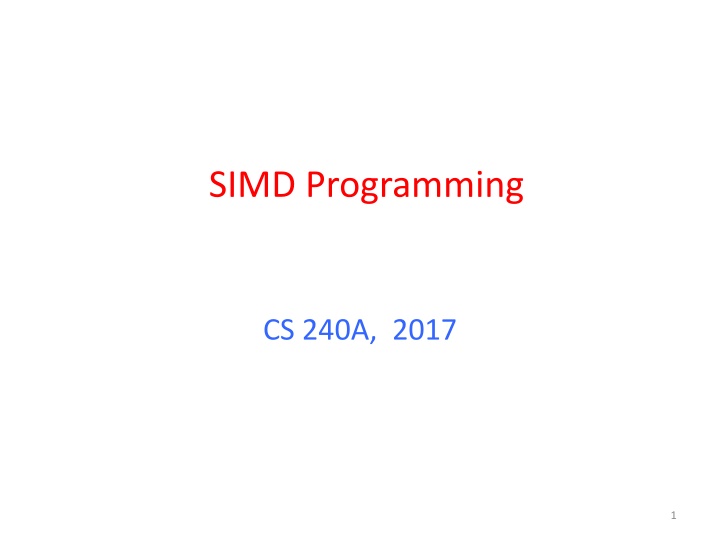
Exploring SIMD Programming and Flynn's Taxonomy in Parallel Processing Architectures
Understand the concepts of Single Instruction Multiple Data (SIMD) programming and Flynn's Taxonomy in parallel processing architectures. Dive into the utilization of SIMD extensions, Fused Multiply-Add (FMA) instructions, optimization techniques, and Intel SIMD extensions like MMX, SSE, and AVX to enhance computational efficiency. Learn how to leverage these technologies to maximize performance in scientific computing, signal processing, and multimedia applications.
Download Presentation

Please find below an Image/Link to download the presentation.
The content on the website is provided AS IS for your information and personal use only. It may not be sold, licensed, or shared on other websites without obtaining consent from the author. If you encounter any issues during the download, it is possible that the publisher has removed the file from their server.
You are allowed to download the files provided on this website for personal or commercial use, subject to the condition that they are used lawfully. All files are the property of their respective owners.
The content on the website is provided AS IS for your information and personal use only. It may not be sold, licensed, or shared on other websites without obtaining consent from the author.
E N D
Presentation Transcript
SIMD Programming CS 240A, 2017 1
Flynn* Taxonomy, 1966 In 2013, SIMD and MIMD most common parallelism in architectures usually both in same system! Most common parallel processing programming style: Single Program Multiple Data ( SPMD ) Single program that runs on all processors of a MIMD Cross-processor execution coordination using synchronization primitives SIMD (aka hw-level data parallelism): specialized function units, for handling lock-step calculations involving arrays Scientific computing, signal processing, multimedia (audio/video processing) *Prof. Michael Flynn, Stanford 2
Single-Instruction/Multiple-Data Stream (SIMD or sim-dee ) SIMD computer exploits multiple data streams against a single instruction stream to operations that may be naturally parallelized, e.g., Intel SIMD instruction extensions or NVIDIA Graphics Processing Unit (GPU) 3
SIMD: Single Instruction, Multiple Data Scalar processing traditional mode one operation produces one result SIMD processing With Intel SSE / SSE2 SSE = streaming SIMD extensions one operation produces multiple results x3 x2 x1 x0 X X + + y3 y2 y1 y0 Y Y X + Y X + Y x3+y3 x2+y2 x1+y1 x0+y0 Slide Source: Alex Klimovitski & Dean Macri, Intel Corporation 4
What does this mean to you? In addition to SIMD extensions, the processor may have other special instructions Fused Multiply-Add (FMA) instructions: x = y + c * z is so common some processor execute the multiply/add as a single instruction, at the same rate (bandwidth) as + or * alone In theory, the compiler understands all of this When compiling, it will rearrange instructions to get a good schedule that maximizes pipelining, uses FMAs and SIMD It works with the mix of instructions inside an inner loop or other block of code But in practice the compiler may need your help Choose a different compiler, optimization flags, etc. Rearrange your code to make things more obvious Using special functions ( intrinsics ) or write in assembly 5
Intel SIMD Extensions MMX 64-bit registers, reusing floating-point registers [1992] SSE2/3/4, new 8 128-bit registers [1999] AVX, new 256-bit registers [2011] Space for expansion to 1024-bit registers 6
SSE / SSE2 SIMD on Intel SSE2 data types: anything that fits into 16 bytes, e.g., 4x floats 2x doubles 16x bytes Instructions perform add, multiply etc. on all the data in parallel Similar on GPUs, vector processors (but many more simultaneous operations) 7
Intel Architecture SSE2+ 128-Bit SIMD Data Types Note: in Intel Architecture (unlike MIPS) a word is 16 bits Single-precision FP: Double word (32 bits) Double-precision FP: Quad word (64 bits) 16 / 128 bits 122 121 96 95 80 79 64 63 48 47 32 31 16 15 8 / 128 bits 122 121 96 95 80 79 64 63 48 47 32 31 16 15 96 95 64 63 32 31 4 / 128 bits 64 63 2 / 128 bits 8
Packed and Scalar Double-Precision Floating-Point Operations Packed Scalar 9
SSE/SSE2 Floating Point Instructions Move does both load and store xmm: one operand is a 128-bit SSE2 register mem/xmm: other operand is in memory or an SSE2 register {SS} Scalar Single precision FP: one 32-bit operand in a 128-bit register {PS} Packed Single precision FP: four 32-bit operands in a 128-bit register {SD} Scalar Double precision FP: one 64-bit operand in a 128-bit register {PD} Packed Double precision FP, or two 64-bit operands in a 128-bit register {A} 128-bit operand is aligned in memory {U} means the 128-bit operand is unaligned in memory {H} means move the high half of the 128-bit operand {L} means move the low half of the 128-bit operand 10
Example: SIMD Array Processing for each f in array f = sqrt(f)for each f in array { load f to floating-point register calculate the square root write the result from the register to memory } for each 4 members in array { load 4 members to the SSE register calculate 4 square roots in one operation store the 4 results from the register to memory } SIMD style 11
Data-Level Parallelism and SIMD SIMD wants adjacent values in memory that can be operated in parallel Usually specified in programs as loops for(i=1000; i>0; i=i-1) x[i] = x[i] + s; How can reveal more data-level parallelism than available in a single iteration of a loop? Unroll loop and adjust iteration rate 12
Loop Unrolling in C Instead of compiler doing loop unrolling, could do it yourself in C for(i=1000; i>0; i=i-1) x[i] = x[i] + s; Could be rewritten for(i=1000; i>0; i=i-4) { x[i] = x[i] + s; x[i-1] = x[i-1] + s; x[i-2] = x[i-2] + s; x[i-3] = x[i-3] + s; } 13
Generalizing Loop Unrolling A loop of n iterations k copies of the body of the loop Assuming (n mod k) 0 Then we will run the loop with 1 copy of the body (n mod k) times and then with k copies of the body floor(n/k) times 14
General Loop Unrolling with a Head Handing loop iterations indivisible by step size. for(i=1003; i>0; i=i-1) x[i] = x[i] + s; Could be rewritten for(i=1003;i>1000;i--) //Handle the head (1003 mod 4) x[i] = x[i] + s; for(i=1000; i>0; i=i-4) {//handle other iterations x[i] = x[i] + s; x[i-1] = x[i-1] + s; x[i-2] = x[i-2] + s; x[i-3] = x[i-3] + s; } 15
Tail method for general loop unrolling Handing loop iterations indivisible by step size. for(i=1003; i>0; i=i-1) x[i] = x[i] + s; Could be rewritten for(i=1003; i>0 && i> 1003 mod 4; i=i-4) { x[i] = x[i] + s; x[i-1] = x[i-1] + s; x[i-2] = x[i-2] + s; x[i-3] = x[i-3] + s; } for( i= 1003 mod 4; i>0; i--) //special handle in tail x[i] = x[i] + s; 16
Another loop unrolling example Normal loop After loop unrolling int x; for (x = 0; x < 103/5*5; x += 5) { delete(x); delete(x + 1); delete(x + 2); delete(x + 3); delete(x + 4); } /*Tail*/ for (x = 103/5*5; x < 103; x++) { delete(x); } int x; for (x = 0; x < 103; x++) { delete(x); } 17
Intel SSE Intrinsics Intrinsics are C functions and procedures for inserting assembly language into C code, including SSE instructions Instrinsics: Corresponding SSE instructions: Vector data type: _m128d Load and store operations: _mm_load_pd _mm_store_pd _mm_loadu_pd _mm_storeu_pd Load and broadcast across vector _mm_load1_pd Arithmetic: _mm_add_pd _mm_mul_pd MOVAPD/aligned, packed double MOVAPD/aligned, packed double MOVUPD/unaligned, packed double MOVUPD/unaligned, packed double MOVSD + shuffling/duplicating ADDPD/add, packed double MULPD/multiple, packed double 18
Example 1: Use of SSE SIMD instructions For (i=0; i<n; i++) sum = sum+ a[i]; Set 128-bit temp=0; For (i = 0; n/4*4; i=i+4){ Add 4 integers with 128 bits from &a[i] to temp; } Tail: Copy out 4 integers of temp and add them together to sum. For(i=n/4*4; i<n; i++) sum += a[i]; 19
Related SSE SIMD instructions __m128i _mm_setzero_si128( ) returns 128-bit zero vector Load data stored at pointer p of memory to a 128bit vector, returns this vector. __m128i _mm_loadu_si128( __m128i *p ) __m128i _mm_add_epi32( __m128i a, __m128i b ) returns vector (a0+b0, a1+b1, a2+b2, a3+b3) void _mm_storeu_si128( __m128i *p, __m128i a ) stores content off 128-bit vector a ato memory starting at pointer p 20
Related SSE SIMD instructions Add 4 integers with 128 bits from &a[i] to temp vector with loop body temp = temp + a[i] Add 128 bits, then next 128 bits __m128i temp=_mm_setzero_si128(); __m128i temp1=_mm_loadu_si128((__m128i *)(a+i)); temp=_mm_add_epi32(temp, temp1) 21
Example 2: 2 x 2 Matrix Multiply Definition of Matrix Multiply: 2 Ci,j = (A B)i,j = Ai,k Bk,j k = 1 A1,1 A1,2 B1,1 B1,2 C1,1=A1,1B1,1 + A1,2B2,1 C1,2=A1,1B1,2+A1,2B2,2 x = A2,1 A2,2 B2,1 B2,2 C2,1=A2,1B1,1 + A2,2B2,1 C2,2=A2,1B1,2+A2,2B2,2 1 0 1 3 C1,1= 1*1+ 0*2 = 1 C1,2= 1*3 + 0*4 = 3 x = 0 1 2 4 C2,1= 0*1 + 1*2 = 2 C2,2= 0*3 + 1*4 = 4 22
Example: 2 x 2 Matrix Multiply Using the XMM registers 64-bit/double precision/two doubles per XMM reg C1 C1,1 C2,1 Stored in memory in Column order C2 C1,2 C2,2 A A1,i A2,i B1 Bi,1 Bi,1 C1 C2 B2 Bi,2 Bi,2 23
Example: 2 x 2 Matrix Multiply Initialization C1 0 0 C2 0 0 I = 1 _mm_load_pd: Stored in memory in Column order A A1,1 A2,1 _mm_load1_pd: SSE instruction that loads a double word and stores it in the high and low double words of the XMM register B1 B1,1 B1,1 B2 B1,2 B1,2 24
Example: 2 x 2 Matrix Multiply A1,1 A1,2 B1,1 B1,2 C1,1=A1,1B1,1 + A1,2B2,1 C1,2=A1,1B1,2+A1,2B2,2 x = A2,1 A2,2 B2,1 B2,2 C2,1=A2,1B1,1 + A2,2B2,1 C2,2=A2,1B1,2+A2,2B2,2 Initialization C1 0 0 C2 0 0 I = 1 _mm_load_pd: Load 2 doubles into XMM reg, Stored in memory in Column order A A1,1 A2,1 _mm_load1_pd: SSE instruction that loads a double word and stores it in the high and low double words of the XMM register (duplicates value in both halves of XMM) B1 B1,1 B1,1 B2 B1,2 B1,2 25
Example: 2 x 2 Matrix Multiply A1,1 A1,2 B1,1 B1,2 C1,1=A1,1B1,1 + A1,2B2,1 C1,2=A1,1B1,2+A1,2B2,2 x = A2,1 A2,2 B2,1 B2,2 C2,1=A2,1B1,1 + A2,2B2,1 C2,2=A2,1B1,2+A2,2B2,2 First iteration intermediate result C1 0+A1,1B1,1 0+A2,1B1,1 c1 = _mm_add_pd(c1,_mm_mul_pd(a,b1)); c2 = _mm_add_pd(c2,_mm_mul_pd(a,b2)); SSE instructions first do parallel multiplies and then parallel adds in XMM registers C2 0+A1,1B1,2 0+A2,1B1,2 I = 1 _mm_load_pd: Stored in memory in Column order A A1,1 A2,1 _mm_load1_pd: SSE instruction that loads a double word and stores it in the high and low double words of the XMM register (duplicates value in both halves of XMM) B1 B1,1 B1,1 B2 B1,2 B1,2 26
Example: 2 x 2 Matrix Multiply A1,1 A1,2 B1,1 B1,2 C1,1=A1,1B1,1 + A1,2B2,1 C1,2=A1,1B1,2+A1,2B2,2 x = A2,1 A2,2 B2,1 B2,2 C2,1=A2,1B1,1 + A2,2B2,1 C2,2=A2,1B1,2+A2,2B2,2 First iteration intermediate result C1 0+A1,1B1,1 0+A2,1B1,1 c1 = _mm_add_pd(c1,_mm_mul_pd(a,b1)); c2 = _mm_add_pd(c2,_mm_mul_pd(a,b2)); SSE instructions first do parallel multiplies and then parallel adds in XMM registers C2 0+A1,1B1,2 0+A2,1B1,2 I = 2 _mm_load_pd: Stored in memory in Column order A A1,2 A2,2 _mm_load1_pd: SSE instruction that loads a double word and stores it in the high and low double words of the XMM register (duplicates value in both halves of XMM) B1 B2,1 B2,1 B2 B2,2 B2,2 27
Example: 2 x 2 Matrix Multiply Second iteration intermediate result C1,1 C2,1 C1 A1,1B1,1+A1,2B2,1 A2,1B1,1+A2,2B2,1 c1 = _mm_add_pd(c1,_mm_mul_pd(a,b1)); c2 = _mm_add_pd(c2,_mm_mul_pd(a,b2)); SSE instructions first do parallel multiplies and then parallel adds in XMM registers C2 A1,1B1,2+A1,2B2,2 C1,2 A2,1B1,2+A2,2B2,2 C2,2 I = 2 _mm_load_pd: Stored in memory in Column order A A1,2 A2,2 _mm_load1_pd: SSE instruction that loads a double word and stores it in the high and low double words of the XMM register (duplicates value in both halves of XMM) B1 B2,1 B2,1 B2 B2,2 B2,2 28
Example: 2 x 2 Matrix Multiply (Part 1 of 2) // Initialize A, B, C for example /* A = (note column order!) 1 0 0 1 */ A[0] = 1.0; A[1] = 0.0; A[2] = 0.0; A[3] = 1.0; #include <stdio.h> // header file for SSE compiler intrinsics #include <emmintrin.h> // NOTE: vector registers will be represented in comments as v1 = [ a | b] // where v1 is a variable of type __m128d and a, b are doubles /* B = (note column order!) 1 3 2 4 */ B[0] = 1.0; B[1] = 2.0; B[2] = 3.0; B[3] = 4.0; int main(void) { // allocate A,B,C aligned on 16-byte boundaries double A[4] __attribute__ ((aligned (16))); double B[4] __attribute__ ((aligned (16))); double C[4] __attribute__ ((aligned (16))); int lda = 2; int i = 0; // declare several 128-bit vector variables __m128d c1,c2,a,b1,b2; /* C = (note column order!) 0 0 0 0 */ C[0] = 0.0; C[1] = 0.0; C[2] = 0.0; C[3] = 0.0; 29
Example: 2 x 2 Matrix Multiply (Part 2 of 2) // used aligned loads to set // c1 = [c_11 | c_21] c1 = _mm_load_pd(C+0*lda); // c2 = [c_12 | c_22] c2 = _mm_load_pd(C+1*lda); for (i = 0; i < 2; i++) { /* a = i = 0: [a_11 | a_21] i = 1: [a_12 | a_22] */ a = _mm_load_pd(A+i*lda); /* b1 = i = 0: [b_11 | b_11] i = 1: [b_21 | b_21] */ b1 = _mm_load1_pd(B+i+0*lda); /* b2 = i = 0: [b_12 | b_12] i = 1: [b_22 | b_22] */ b2 = _mm_load1_pd(B+i+1*lda); /* c1 = i = 0: [c_11 + a_11*b_11 | c_21 + a_21*b_11] i = 1: [c_11 + a_21*b_21 | c_21 + a_22*b_21] */ c1 = _mm_add_pd(c1,_mm_mul_pd(a,b1)); /* c2 = i = 0: [c_12 + a_11*b_12 | c_22 + a_21*b_12] i = 1: [c_12 + a_21*b_22 | c_22 + a_22*b_22] */ c2 = _mm_add_pd(c2,_mm_mul_pd(a,b2)); } // store c1,c2 back into C for completion _mm_store_pd(C+0*lda,c1); _mm_store_pd(C+1*lda,c2); // print C printf("%g,%g\n%g,%g\n",C[0],C[2],C[1],C[3]); return 0; } 30
Conclusion Flynn Taxonomy Intel SSE SIMD Instructions Exploit data-level parallelism in loops One instruction fetch that operates on multiple operands simultaneously 128-bit XMM registers SSE Instructions in C Embed the SSE machine instructions directly into C programs through use of intrinsics Achieve efficiency beyond that of optimizing compiler 31

